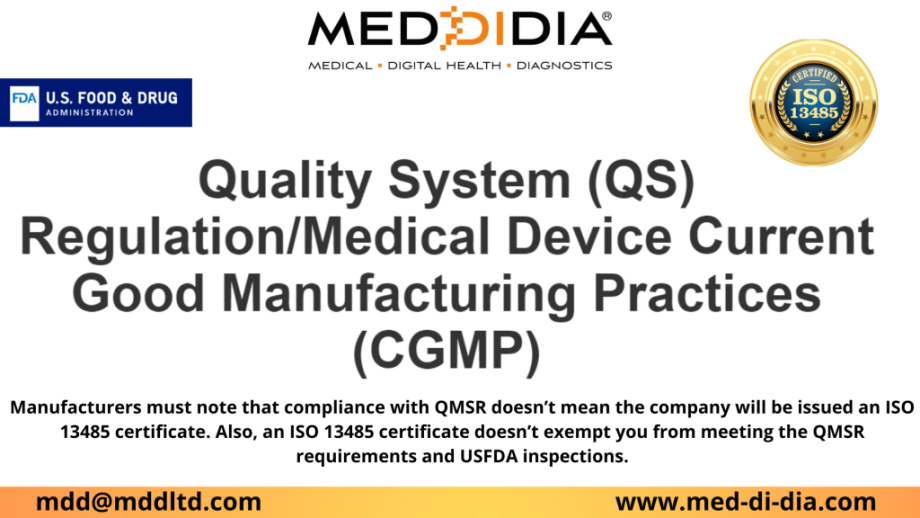The Current Medical Device Good Manufacturing Practices [CGMP] are the quality systems that medical device manufacturers must establish and follow to help ensure that their products consistently meet applicable requirements and specifications. The CGMP requirements of the Quality System (QS) Regulation for the devices are codified in 21 CFR Part 820, first authorised by section 520 (f) of the Federal Food, Drug, and Cosmetic Act and revised in 1996 to incorporate design controls, and international standards are now being replaced.
On 31st January 2024, the United States Food and Drug Administrator [USFDA] published an update where the QSR – Quality System Regulation requiring CGMP will be replaced by QSMR – Quality System Management Regulation which harmonises with the global footstep. Under the QSMR, medical device manufacturers will have to transition their quality management systems in a way that they align with the ISO 13485 standard. The FDA has determined that the requirements in ISO 13485 are, when taken in totality, substantially similar to the requirements of the QS regulation, providing a similar level of assurance in a firm’s quality management system and ability to consistently manufacture devices that are safe and effective and otherwise in compliance with the Federal Food, Drug, and Cosmetic Act (FD&C Act).
Key updates with the new rule - Quality Management System Regulation:
- The new rules amend the title of the regulation from QS Regulations (QSR) to QMS Regulations (QMSR).
- QSMR establishes additional requirements that clarify certain expectations and certain concepts used in ISO 13485. These additions ensure that the incorporation by reference of ISO 13485 does not create inconsistencies with other applicable FDA requirements.
- The FDA has made conforming edits to part 4 (21 CFR part 4) to clarify the device Quality Management System (QMS) requirements for combination products. These edits do not impact the CGMP requirements for combination products.
- The rule is effective two years after publication in the Federal Register. Until then, manufacturers are required to comply with the QS regulation. The FDA will begin to enforce the QMSR requirements upon the effective date, February 2, 2026.
- The FDA will develop an inspection process to align with the requirements of the new Quality Management System Regulation (QMSR).
“This final rule is the latest action taken by the FDA to promote global harmonization in device regulation to help assure that patients and providers have timely and continued access to safe, effective, and high-quality medical devices both at home and abroad,” said Jeff Shuren, director of FDA’s Center for Devices and Radiological Health (CDRH). “By harmonizing key areas of a medical device manufacturer’s quality management system with the international standard, the FDA is streamlining actions device manufacturers must take to meet requirements by multiple regulatory authorities.”
The industry has until 2 February 2026 to comply with the new rule and can continue to comply with requirements under the current QS regulation until then.
While the USFDA has given plenty of time to adopt new requirements, regulatory experts believe manufacturers should take a proactive approach and not wait until the last minute. ISO13485 is a live and living document that requires regular audits and updates. These audits ensure product safety and efficacy, which ultimately makes a ‘Safe product’ for patient use. Early adoption of QMSR will benefit the industry and not affect the supply of vital devices.
Food for thought: If the MedTech industry was a kingdom, would the companies crown ISO 13485 as one of the kings?
What are the differences between QSR and QMSR?
- FDA proposes incorporating ISO 13485 “by reference,” meaning the new QMSR will address certain requirements by referencing their location in ISO 13485:2016.
- FDA states they are “proposing additional definitions, clarifying concepts, and additional requirements, all of which would require compliance within a manufacturer’s QMS in addition to ISO 13485.”
- ISO 13485 has a greater emphasis on risk management requirements.
-
‘Device Master Record’ requirement of QSR could be terminated as the ISO 13485 requires ‘Medical Device File’ as a document. [Just change of names or change in contents as well? – Ask a Regulatory expert! – email us mdd@mddltd.com ]
- Section 5, Part B of QMSR highlights the FDA’s stance on melding Part 820’s definitions with those of ISO 13485.
- The rule also includes several new sections in Part 820:
- Section 820.7 - Incorporation by reference
- Section 820.10 - Requirements for a quality management system
- Section 820.15 - Clarification of concepts
- Section 820.35 - Control of records
- Section 820.45 - Device labelling and packaging controls [based on the product recall incidents, this would have a substantial impact on requirements]
- Section 820.45 will require “procedures that provide a detailed description of labelling and packaging activities to ensure the integrity, inspection, storage, and operations for labelling and repackaging.”
f.1. The main items Section 820.45 will require are:
f.1.1. UDI or UPC
f.1.2. Expiration date
f.1.3. Storage instructions
f.1.4. Handling instructions
f.1.5. Processing instructions
What should Medical Device Manufacturers do with QMSR?
- Focus on product Recall management strategy.
- Focus on labelling requirements.
- Prepare to transition from Device Master Record to Medical Device File.
- The rule may also change the current Quality System Inspection Technique (QSIT) to match the new QMSR requirements.
- Begin your journey towards compliance by adopting practices mentioned in the ISO 13485 standard.
Manufacturers must note that compliance with QMSR doesn’t mean the company will be issued an ISO 13485 certificate. Also, an ISO 13485 certificate doesn’t exempt you from meeting the QMSR requirements and USFDA inspections.
With uncertainty still in play, manufacturers must work in tandem with regulatory compliance consultancies as they have the capacity and expertise to provide additional support when your existing regulatory functions are regularly overhauled with new requirements.
Connect with Regulatory Experts and Consultants at Med-Di-Dia by sending us an email at mdd@mddltd.com or by filing this webform - https://mailchi.mp/f2b4ceba59f8/qms



